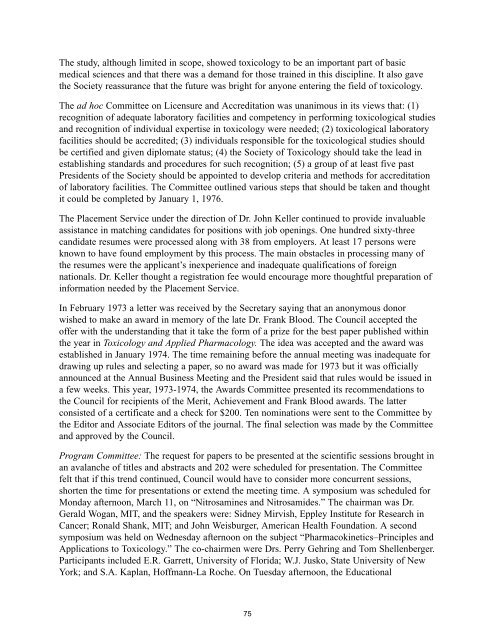SOCIETY O. TOXICOLOGY HISTORY - Society of Toxicology
SOCIETY O. TOXICOLOGY HISTORY - Society of Toxicology
SOCIETY O. TOXICOLOGY HISTORY - Society of Toxicology
You also want an ePaper? Increase the reach of your titles
YUMPU automatically turns print PDFs into web optimized ePapers that Google loves.
The study, although limited in scope, showed toxicology to be an important part <strong>of</strong> basic<br />
medical sciences and that there was a demand for those trained in this discipline. It also gave<br />
the <strong>Society</strong> reassurance that the future was bright for anyone entering the field <strong>of</strong> toxicology.<br />
The ad hoc Committee on Licensure and Accreditation was unanimous in its views that: (1)<br />
recognition <strong>of</strong> adequate laboratory facilities and competency in performing toxicological studies<br />
and recognition <strong>of</strong> individual expertise in toxicology were needed; (2) toxicological laboratory<br />
facilities should be accredited; (3) individuals responsible for the toxicological studies should<br />
be certified and given diplomate status; (4) the <strong>Society</strong> <strong>of</strong> <strong>Toxicology</strong> should take the lead in<br />
establishing standards and procedures for such recognition; (5) a group <strong>of</strong> at least five past<br />
Presidents <strong>of</strong> the <strong>Society</strong> should be appointed to develop criteria and methods for accreditation<br />
<strong>of</strong> laboratory facilities. The Committee outlined various steps that should be taken and thought<br />
it could be completed by January 1, 1976.<br />
The Placement Service under the direction <strong>of</strong> Dr. John Keller continued to provide invaluable<br />
assistance in matching candidates for positions with job openings. One hundred sixty-three<br />
candidate resumes were processed along with 38 from employers. At least 17 persons were<br />
known to have found employment by this process. The main obstacles in processing many <strong>of</strong><br />
the resumes were the applicant’s inexperience and inadequate qualifications <strong>of</strong> foreign<br />
nationals. Dr. Keller thought a registration fee would encourage more thoughtful preparation <strong>of</strong><br />
information needed by the Placement Service.<br />
In February 1973 a letter was received by the Secretary saying that an anonymous donor<br />
wished to make an award in memory <strong>of</strong> the late Dr. Frank Blood. The Council accepted the<br />
<strong>of</strong>fer with the understanding that it take the form <strong>of</strong> a prize for the best paper published within<br />
the year in <strong>Toxicology</strong> and Applied Pharmacology. The idea was accepted and the award was<br />
established in January 1974. The time remaining before the annual meeting was inadequate for<br />
drawing up rules and selecting a paper, so no award was made for 1973 but it was <strong>of</strong>ficially<br />
announced at the Annual Business Meeting and the President said that rules would be issued in<br />
a few weeks. This year, 1973-1974, the Awards Committee presented its recommendations to<br />
the Council for recipients <strong>of</strong> the Merit, Achievement and Frank Blood awards. The latter<br />
consisted <strong>of</strong> a certificate and a check for $200. Ten nominations were sent to the Committee by<br />
the Editor and Associate Editors <strong>of</strong> the journal. The final selection was made by the Committee<br />
and approved by the Council.<br />
Program Committee: The request for papers to be presented at the scientific sessions brought in<br />
an avalanche <strong>of</strong> titles and abstracts and 202 were scheduled for presentation. The Committee<br />
felt that if this trend continued, Council would have to consider more concurrent sessions,<br />
shorten the time for presentations or extend the meeting time. A symposium was scheduled for<br />
Monday afternoon, March 11, on “Nitrosamines and Nitrosamides.” The chairman was Dr.<br />
Gerald Wogan, MIT, and the speakers were: Sidney Mirvish, Eppley Institute for Research in<br />
Cancer; Ronald Shank, MIT; and John Weisburger, American Health Foundation. A second<br />
symposium was held on Wednesday afternoon on the subject “Pharmacokinetics–Principles and<br />
Applications to <strong>Toxicology</strong>.” The co-chairmen were Drs. Perry Gehring and Tom Shellenberger.<br />
Participants included E.R. Garrett, University <strong>of</strong> Florida; W.J. Jusko, State University <strong>of</strong> New<br />
York; and S.A. Kaplan, H<strong>of</strong>fmann-La Roche. On Tuesday afternoon, the Educational<br />
75
















